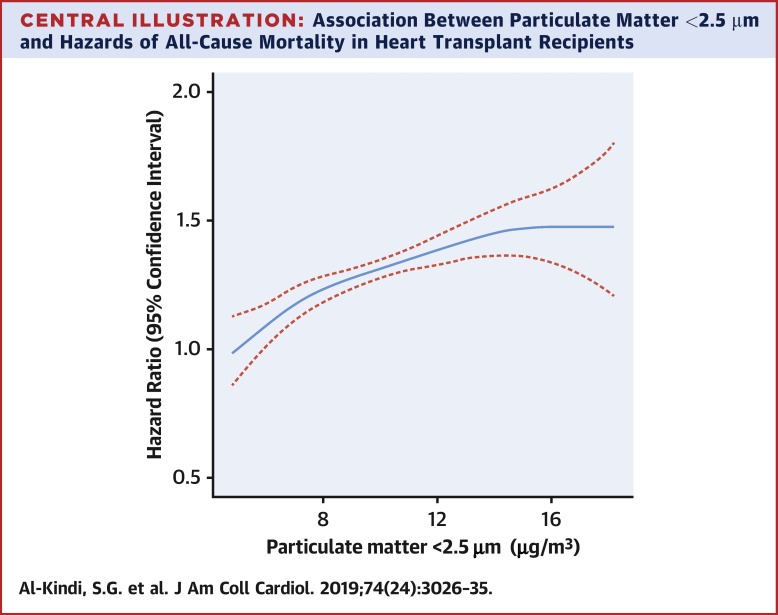当前位置:
X-MOL 学术
›
J. Am. Coll. Cardiol.
›
论文详情
Our official English website, www.x-mol.net, welcomes your
feedback! (Note: you will need to create a separate account there.)
Ambient Air Pollution and Mortality After Cardiac Transplantation
Journal of the American College of Cardiology ( IF 21.7 ) Pub Date : 2019-12-01 , DOI: 10.1016/j.jacc.2019.09.066 Sadeer G Al-Kindi 1 , Anuja Sarode 2 , Melissa Zullo 2 , Jeff Brook 3 , Rick Burnett 4 , Guilherme H Oliveira 1 , Wei Huang 5 , Robert Brook 6 , Sanjay Rajagopalan 7
Journal of the American College of Cardiology ( IF 21.7 ) Pub Date : 2019-12-01 , DOI: 10.1016/j.jacc.2019.09.066 Sadeer G Al-Kindi 1 , Anuja Sarode 2 , Melissa Zullo 2 , Jeff Brook 3 , Rick Burnett 4 , Guilherme H Oliveira 1 , Wei Huang 5 , Robert Brook 6 , Sanjay Rajagopalan 7
Affiliation

|
BACKGROUND
Heart transplant recipients are at high risk for mortality, with traditional risk scores performing modestly in predicting post-transplant survival, underscoring the importance of as yet unidentified factors in determining prognosis. In this analysis, the association between PM2.5 exposure levels and survival after heart transplantation were investigated. OBJECTIVES
This study sought to study the association between PM2.5 exposure and mortality following heart transplantation. METHODS
On the basis of the zip code of residence, mortality data in patients who underwent heart transplantation (2004 to 2015) in the United Network for Organ Sharing (UNOS) database were linked with validated estimates of fine particulate matter concentrations (particles with diameter <2.5 μm [PM2.5]; 1 × 1-km grids) for each calendar year during which a UNOS cardiac transplant recipient was at risk for death. Cox proportional hazard models were used to estimate the relationship between exposure and overall mortality adjusting for recipient, donor, and neighborhood variables. RESULTS
A total of 21,800 patients with 86,713 patient-years of follow-up was included. Mean age at transplantation was 52.6 ± 12.6 years, 75% were male, 69% were white, and 39% had ischemic etiology of heart failure. Mean annual exposure to PM2.5 was 10.6 ± 2.3 μg/m3. At a median follow-up of 4.8 (95% confidence interval: 2.0 to 7.8) years, 5,208 patients (23.9%) had died. The estimated mortality hazard ratio, per 10 μg/m3 increment increase in annual PM2.5 exposure was 1.43 (95% confidence interval: 1.21 to 1.49). After adjusting for 30 recipient, donor, and neighborhood variables, the estimated mortality hazard ratio per 10 μg/m3 increment in annual exposure to PM2.5 was 1.26 (95% confidence interval: 1.11 to 1.43) relative increase in hazard of mortality. This association was consistent across subgroups. CONCLUSIONS
This study provides evidence linking air pollution with mortality after heart transplantation. These results suggest an important influence of a key environmental factor in outcomes following heart transplantation, and supports the need for further studies in this population.
中文翻译:

心脏移植术后环境空气污染和死亡率
背景心脏移植受者处于高死亡风险中,传统风险评分在预测移植后存活率方面表现适度,强调了尚未确定的因素在决定预后中的重要性。在这项分析中,研究了 PM2.5 暴露水平与心脏移植后存活率之间的关联。目的 本研究旨在研究 PM2.5 暴露与心脏移植后死亡率之间的关联。方法 根据居住地的邮政编码,器官共享联合网络 (UNOS) 数据库中接受心脏移植的患者(2004 年至 2015 年)的死亡率数据与细颗粒物浓度(直径 < 2.5 微米 [PM2.5];1 × 1 公里网格)用于 UNOS 心脏移植受者有死亡风险的每个日历年。Cox 比例风险模型用于估计暴露与总体死亡率之间的关系,并针对受者、捐赠者和邻里变量进行调整。结果 共纳入 21,800 名患者,随访时间为 86,713 患者年。移植时的平均年龄为 52.6 ± 12.6 岁,75% 为男性,69% 为白人,39% 为心力衰竭的缺血性病因。PM2.5 的年平均暴露量为 10.6 ± 2.3 μg/m3。中位随访时间为 4.8(95% 置信区间:2.0 至 7.8)年,有 5,208 名患者(23.9%)死亡。每年 PM2.5 暴露量每增加 10 μg/m3 的估计死亡率风险比为 1.43(95% 置信区间:1.21 至 1.49)。调整了 30 个受赠人、捐赠人后,和邻里变量,PM2.5 年暴露量每增加 10 μg/m3 的估计死亡率风险比为 1.26(95% 置信区间:1.11 至 1.43),死亡率风险相对增加。这种关联在亚组之间是一致的。结论 本研究提供了将空气污染与心脏移植后死亡率联系起来的证据。这些结果表明关键环境因素对心脏移植后的结果有重要影响,并支持对这一人群进行进一步研究的必要性。结论 本研究提供了将空气污染与心脏移植后死亡率联系起来的证据。这些结果表明关键环境因素对心脏移植后的结果有重要影响,并支持对这一人群进行进一步研究的必要性。结论 本研究提供了将空气污染与心脏移植后死亡率联系起来的证据。这些结果表明关键环境因素对心脏移植后的结果有重要影响,并支持对这一人群进行进一步研究的必要性。
更新日期:2019-12-01
中文翻译:

心脏移植术后环境空气污染和死亡率
背景心脏移植受者处于高死亡风险中,传统风险评分在预测移植后存活率方面表现适度,强调了尚未确定的因素在决定预后中的重要性。在这项分析中,研究了 PM2.5 暴露水平与心脏移植后存活率之间的关联。目的 本研究旨在研究 PM2.5 暴露与心脏移植后死亡率之间的关联。方法 根据居住地的邮政编码,器官共享联合网络 (UNOS) 数据库中接受心脏移植的患者(2004 年至 2015 年)的死亡率数据与细颗粒物浓度(直径 < 2.5 微米 [PM2.5];1 × 1 公里网格)用于 UNOS 心脏移植受者有死亡风险的每个日历年。Cox 比例风险模型用于估计暴露与总体死亡率之间的关系,并针对受者、捐赠者和邻里变量进行调整。结果 共纳入 21,800 名患者,随访时间为 86,713 患者年。移植时的平均年龄为 52.6 ± 12.6 岁,75% 为男性,69% 为白人,39% 为心力衰竭的缺血性病因。PM2.5 的年平均暴露量为 10.6 ± 2.3 μg/m3。中位随访时间为 4.8(95% 置信区间:2.0 至 7.8)年,有 5,208 名患者(23.9%)死亡。每年 PM2.5 暴露量每增加 10 μg/m3 的估计死亡率风险比为 1.43(95% 置信区间:1.21 至 1.49)。调整了 30 个受赠人、捐赠人后,和邻里变量,PM2.5 年暴露量每增加 10 μg/m3 的估计死亡率风险比为 1.26(95% 置信区间:1.11 至 1.43),死亡率风险相对增加。这种关联在亚组之间是一致的。结论 本研究提供了将空气污染与心脏移植后死亡率联系起来的证据。这些结果表明关键环境因素对心脏移植后的结果有重要影响,并支持对这一人群进行进一步研究的必要性。结论 本研究提供了将空气污染与心脏移植后死亡率联系起来的证据。这些结果表明关键环境因素对心脏移植后的结果有重要影响,并支持对这一人群进行进一步研究的必要性。结论 本研究提供了将空气污染与心脏移植后死亡率联系起来的证据。这些结果表明关键环境因素对心脏移植后的结果有重要影响,并支持对这一人群进行进一步研究的必要性。











































 京公网安备 11010802027423号
京公网安备 11010802027423号